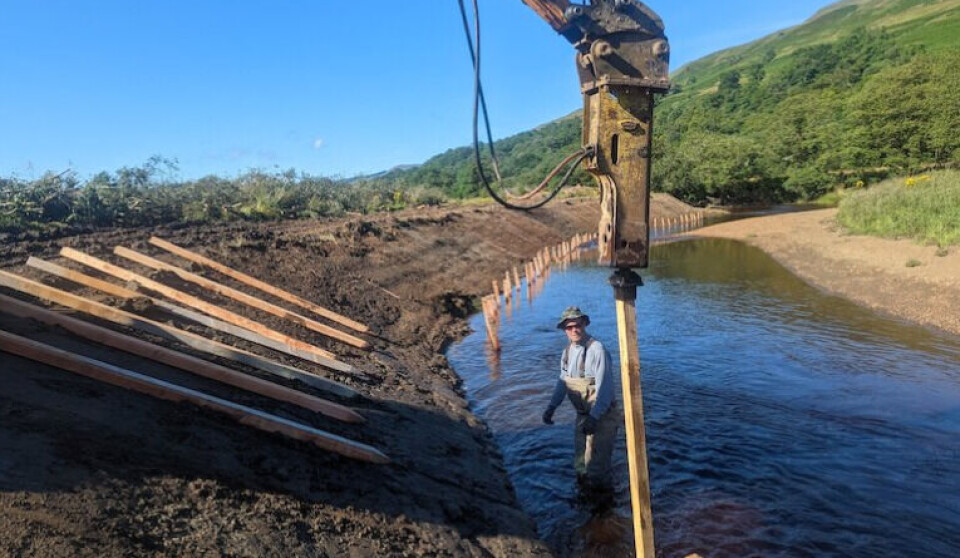
New funding round opens for wild salmon projects
Fish farmers will give up to £140,000 to efforts to help fish this year
Applications are being invited for a new round of funding from fish farmers for projects aimed at helping Scotland’s endangered wild salmon.
Trade body Salmon Scotland’s wild fisheries fund has up to £140,000 available in 2024 to help address the decades-long decline in fish numbers. It is part of a five-year investment of £1.5 million from the sector.
Projects that could win funding include those that restore habitats, provide protection from predators, and encourage river restocking schemes.
The fund is open to all river catchment organisations throughout the whole of Scotland in 2024, but organisers have suggested that there is a particular interest in projects in the shared zone of aquaculture and wild salmon fisheries. Applications can be made here.
Wild salmon and sea trout populations throughout the UK have
been in decline for decades, with habitat loss and rising river and sea
temperatures as two major causes. Other pressures facing wild salmon, including
non-native plants, predation by fish, birds and seals, and obstacles to fish
passage including dams and weirs.
Some anglers also blame sea lice from salmon farms for a decline of both salmon and particularly sea trout, which spend their lives in coastal waters, but there is currently little evidence to confirm this assertion. A Scottish Government-funded study in Loch Linnhe, which has several salmon farms, found very few lice larvae in net samples.
1-5% return rate
Only 1-5% of wild Atlantic salmon that migrate to sea return to their natal rivers in Scotland, compared to around 25% only 30 years ago.
Initially conceived in 2021 as the Wild Salmonid Fund before being rebranded last year, the initiative enters its fourth year having already invested more than £335,000 in relevant projects.
Last year Salmon Scotland launched a dedicated website to support the fund, ensuring transparency on the amount of funding projects received.
Every project which has received funding since 2021 is listed, and visitors can keep up to date on progress.
Tree canopy
To date, grants have been used to save and restore a historic dam in the Western Isles that assists wild salmon to progress to their spawning grounds, as well as for restoration projects to reduce riverbank erosion and measures to provide tree canopy and in-stream cover for young salmon.
The 2024 fund will again be co-ordinated by Jon Gibb, a fisheries manager based in Fort William who has championed a constructive relationship between the farmed salmon sector and fisheries and angling groups.
The fund opened for applications yesterday (February 1) and the closing date will be March 31, with decisions on grants taken by Salmon Scotland in April.
Open for east coast bids
Gibb said: “As a salmon fishery manager with over 25 years of experience on the west coast of Scotland, I am again delighted to co-ordinate this fund on behalf of Salmon Scotland.
“In 2023 wild Atlantic salmon in Scotland were officially classed as an endangered species.
“This keystone species is under very serious threat from a wide range of impacts both in the river and at sea, and any projects to further understand those impacts and mitigate against them are urgently required.
“I am also delighted that the fund is now available to all Scottish river management organisations including on the east coast of Scotland which has seen a more marked decline in recent years in wild salmon populations than the west coast.”
Constructive engagement
Salmon Scotland chief executive Tavish Scott said there had been a decades-long decline on the east and west coasts of Scotland due to climate change and habitat destruction.
“Scotland’s salmon farmers want to continue playing their part in finding solutions, engaging constructively with the wild fish sector and taking meaningful action to save wild salmon,” said Scott.
“Many salmon farmers are anglers themselves, and most people in the fisheries and angling sectors recognise the importance of a healthy shared environment, ensuring fish can thrive in our waters.
“Through the extraordinary success story of farm-raised salmon, we have developed world-leading expertise in hatching and rearing salmon that can thrive at sea. As well as financial support to projects, our members are sharing their knowledge and experience to support wild fisheries with re-stocking, again showing how collaboration is key to reversing the worrying decline in wild salmon numbers.”
76% decline
According to the International Union for Conservation of Nature (IUCN) the rates of population decline of Atlantic salmon between 2006 and 2021, based on rod catches, were 64% in England, 73% in Wales, and 58% in Scotland. Declines since 2010 have been faster and the 15-year equivalent rates since 2010 were 76% in England, 86% in Wales, and 74% in Scotland, or 76% overall.
The IUCN has declared the Great Britain population of wild Atlantic salmon as “endangered”, the fourth-worst category on its Red List of Threatened Species. The next category is “critically endangered”, followed by “extinct in the wild”, then simply “extinct”.






















































